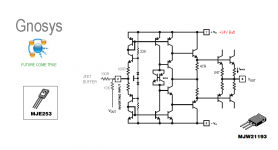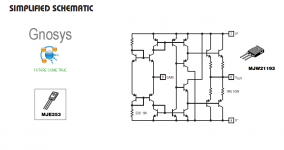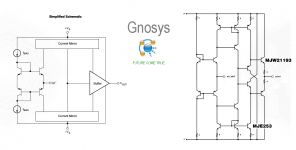Referring to your first schematic, why do you call ot current feedback?
It's not, but simply a conventional amp inverting voltage feedback.
Output voltage will track input voltage, independent of load (that's the definition of voltage output), and gain will be 10K/100 ohms=100X .
What's so special about this very common topology?
Your second schematic does not make sense.
Where is the input signal applied to it?
Besides, it's open loop and *any* real world amplifier will have huge offset or even slam the output against one rail.
It's not, but simply a conventional amp inverting voltage feedback.
Output voltage will track input voltage, independent of load (that's the definition of voltage output), and gain will be 10K/100 ohms=100X .
What's so special about this very common topology?
Your second schematic does not make sense.
Where is the input signal applied to it?
Besides, it's open loop and *any* real world amplifier will have huge offset or even slam the output against one rail.
Stee is an artist; while having absolutely no clue of electronics, he's very good at assembling bits and pieces (from schematic chunks to device pictures) collected from the Internet and then assigning sexy names to those "designs".
While the entertaining value is certainly there, I would not bother to even try to take a closer look at his "design ideas", there's nothing of any technical value there.
While the entertaining value is certainly there, I would not bother to even try to take a closer look at his "design ideas", there's nothing of any technical value there.
OK, fine 😉
I had already noticed the trend you mention but wanted to give him the benefit of the doubt. 🙂
Oh well 🙄
I had already noticed the trend you mention but wanted to give him the benefit of the doubt. 🙂
Oh well 🙄
AN-597 Current Feedback Amplifiers
“Voltage Feedback Vs. Current Feedback
Op Amps,” Application Report . . . . . . . . . . . . . .slva051
References
For more information related to this article,
you can download an Acrobat Reader file
at www-s.ti.com/sc/techlit/litnumber and
replace “litnumber” with the TI Lit. #
for the materials listed below.
Document Title TI Lit. #
1. “Voltage Feedback Vs. Current Feedback
Op Amps,” Application Report . . . . . . . . . . . . . .slva051
2. “The Current-Feedback Op Amp: A High-
Speed Building Block,” Application Bulletin . . .sboa076
3. “Current Feedback Amplifiers: Review,
Stability Analysis, and Applications,”
Application Bulletin . . . . . . . . . . . . . . . . . . . . . . .sboa081
4. “Low-Noise, High-Speed Current Feedback
Amplifiers,” Data Sheet . . . . . . . . . . . . . . . . . . . .slos385
5. “Effect of Parasitic Capacitance in Op Amp
Circuits,” Application Report . . . . . . . . . . . . . . .sloa013
“Voltage Feedback Vs. Current Feedback
Op Amps,” Application Report . . . . . . . . . . . . . .slva051
References
For more information related to this article,
you can download an Acrobat Reader file
at www-s.ti.com/sc/techlit/litnumber and
replace “litnumber” with the TI Lit. #
for the materials listed below.
Document Title TI Lit. #
1. “Voltage Feedback Vs. Current Feedback
Op Amps,” Application Report . . . . . . . . . . . . . .slva051
2. “The Current-Feedback Op Amp: A High-
Speed Building Block,” Application Bulletin . . .sboa076
3. “Current Feedback Amplifiers: Review,
Stability Analysis, and Applications,”
Application Bulletin . . . . . . . . . . . . . . . . . . . . . . .sboa081
4. “Low-Noise, High-Speed Current Feedback
Amplifiers,” Data Sheet . . . . . . . . . . . . . . . . . . . .slos385
5. “Effect of Parasitic Capacitance in Op Amp
Circuits,” Application Report . . . . . . . . . . . . . . .sloa013
- Status
- Not open for further replies.
- Home
- Amplifiers
- Solid State
- GNOSYS amplifier - Future come true



